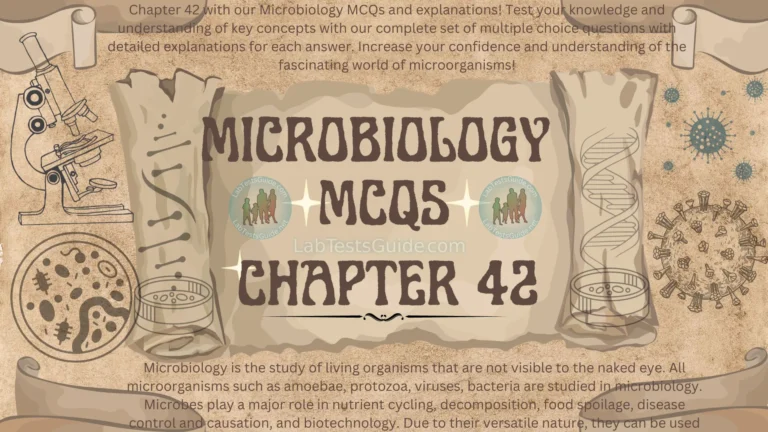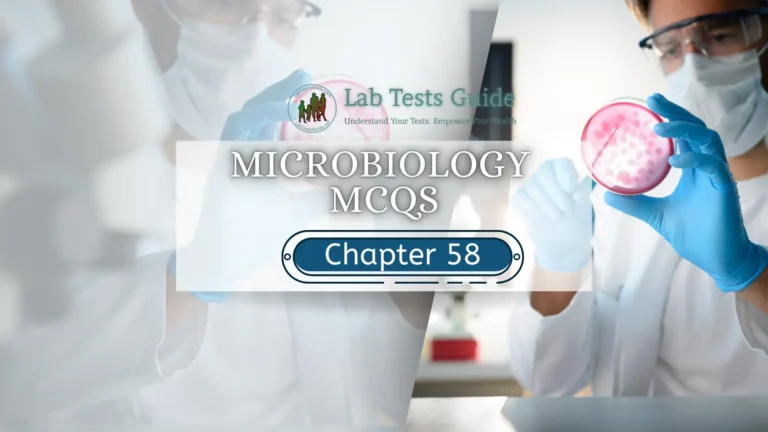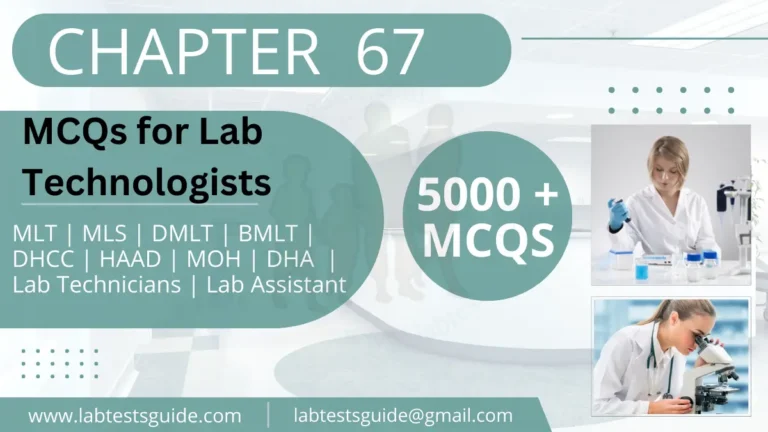6051 to 6100 MCQs for Lab Technician and Technologist Exam Preparation
5000 Plus MCQs for Lab Technician and Technologists are designed to test the knowledge and proficiency of laboratory professionals who work in the field of clinical laboratory science. These questions cover a wide range of topics related to laboratory science, including anatomy, physiology, microbiology, chemistry, and hematology.

If You like then share this to your friends and other social media.
If You have any question and suggestions then please Contact us Here
Questions 6051 to 6100
- A diet containing this fat is helpful in lowering the blood cholesterol level.
- Unsaturated✔
- Saturated
- Vitamin enriched
- Refined
- Phospholipase A2 is an enzyme which removes a fatty acid residue from lecithin to form
- Lecithin fragments
- Phosphotidic acid
- Glyceryl phosphate
- Lysolecithin ✔
- Pancreatic lipose is an enzyme which hydrolyzes facts. It acts as a/an
- peptidase
- hydrolase✔
- carbohydrates
- dehydrogenase
- This interferes with cholesterol absorption
- Lipoprotein lipase
- Creatinase
- 7-dehydrocholesterol
- β-sitosterol✔
- The carbon chain of fatty acids is shortened by 2 carbon atoms at a time. This involves successive reactions catalysed by 4-enzymes. These act the following order:
- Acetyl CoA dehydrogenase, β-OH acyl CoA dehydrogenase, enoyl hydrase, thiolose
- Acyl CoA dehydrogenase, thiolase, enoyl hydrase, β-OH acyl CoA dehydrogenase ✔
- Acyl CoA dehydrogenase, thiolose, enoyl hydrase, β-OH acyl CoA dehydrogenase
- Enoyl hydrase, β-OH acyl CoA dehydrogenase, acyl CoA dehydrogenase, thiolose,
- Acyl carrier protein is involved in the synthesis of
- protein
- glycogen
- fatty acid outside the mitochondria ✔
- fatty acid in the mitochondria
- 1 molecule of palmitic acid on total oxidation to CO2 will yield molecules of ATP (as high energy bonds):
- 129 ✔
- 154
- 83
- 25
- HMG CoA is formed in the metabolism of
- Cholesterol, ketones and leucine ✔
- Cholesterol, fatty acid and Leucine
- Lysine, Lecuine and Isoleucine
- Ketones, Leucine and Lysine
- NADPH is produced when this enzyme acts
- Pyruvate dehydrogenase
- Malic enzyme ✔
- Succinate dehydrogenase
- Malate dehydrogenase
- As a result of each oxidation a long chain fatty acid is cleaved to give
- An acid with 3-carbon less and propionyl CoA
- An acid with 2-carbon less and acetyl CoA ✔
- An acid with 2-carbon less and acetyl CoA
- An acid with 4-carbon and butyryl CoA
- Liposomes are
- Lipid bilayered
- Water in the middle
- Carriers of drugs
- All of these ✔
- Long chain fatty acyl CoA esters are transported across the mitochondrial membrane by
- cAMP
- Prostaglandin
- Carnitine ✔
- Choline
- The acetyl CoA formed on β-oxidation of all long chain fatty acids is metabolized under normal circumstances to
- CO2 and water ✔
- Cholesterol
- Fatty acids
- Ketone bodies
- Very low density lipoproteins are relatively rich in
- Cholesterol
- Triacyl glycerol✔
- Free fatty acids
- Phospholipids
- Neutral fat is stored in
- Liver
- Pancreas
- Adipose tissue ✔
- Brain
- A pathway that requires NADPH as a cofactor is
- Fatty acid oxidation
- Extra mitochondrial denovo fatty acid synthesis ✔
- Ketone bodies formation
- Glycogenesis
- The ‘Committed step’ in the biosynthesis of cholesterol from acetyl CoA is
- Formation of acetoacetyl CoA from acetyl CoA
- Formation of mevalonate from HMG CoA ✔
- Formation of HMG CoA from acetyl CoA and acetoacetyl CoA
- Formation of squalene by squalene synthetase
- In β-Oxidation of fatty acids, which of the following are utilized as coenzymes?
- NAD+ and NADP+
- FADH2 and NADH + H+
- FAD and FMN
- FAD and NAD+ ✔
- The most important source of reducing equivalents for FA synthesis on the liver is
- Glycolysis
- HMP-Shunt ✔
- TCA cycle
- Uronic acid pathway
- All of the following tissue are capable of using ketone bodies except
- Brain
- Renal cortex
- R.B.C. ✔
- Cardiac muscle
- The major source of cholesterol in arterial smooth muscle cells is from
- IDL
- LDL ✔
- HDL
- Chylomicrons
- Ketone bodies are synthesized from fatty acid oxidation products by which of the following organs?
- Liver ✔
- Skeletal muscles
- Kidney
- Brain
- Chain elongation of fatty acids occurring in mammalian liver takes place in which of the following subcellular fractions of the cell?
- Nucleus
- Ribosomes
- Lysosomes
- Microsomes ✔
- Which of the following cofactors or their derivatives must be present for the conversion of acetyl CoA to malonyl CoA extramitochondrial fatty acid synthesis?
- Biotin ✔
- FAD
- FMN
- ACP
- Which of the following statement regarding β-oxidation is true?
- Requires β-ketoacyl CoA as a substrate
- Forms CoA thioesters
- Requires GTP for its activity
- Yields acetyl CoA as a product ✔
- All statements regarding 3-OH-3 methyl glutaryl CoA are true except
- It is formed in the cytoplasm
- Required in ketogenesis ✔
- Involved in synthesis of Fatty acid
- An intermediate in cholesterol biosynthesis
- Which of the following lipoproteins would contribute to a measurement of plasma cholesterol in a normal individual following a 12 hr fast?
- Chylomicrons
- VLDL
- Both VLDL and LDL
- LDL ✔
- All the following statements regarding ketone bodies are true except
- They may result from starvation
- They are formed in kidneys ✔
- They include acetoacetic acid and acetone
- They may be excreted in urine
- In synthesis of Triglyceride from α-Glycero phosphate and acetyl CoA, the first intermediate formed is
- β-diacyl glycerol
- Acyl carnitine
- Monoacyl glycerol
- Phosphatidic acid ✔
- During each cycle of β-oxidation of fatty acid, all the following compounds are generated except
- NADH
- H2O✔
- FAD
- Acyl CoA
- β-Oxidation of odd-carbon fatty acid chain produces
- Succinyl CoA
- Propionyl CoA ✔
- Acetyl CoA
- Malonyl CoA
- Brown adipose tissue is characterized by which of the following?
- Present in large quantities in adult humans
- Mitochondrial content higher than white adipose tissue ✔
- Oxidation and phosphorylation are tightly coupled
- Absent in hibernating animals
- Ketosis in partly ascribed to
- Over production and Glucose
- Under production of Glucose ✔
- Increased carbohydrate utilization
- Increased fat utilization
- The free fatty acids in blood are
- Stored in fat depots
- Mainly bound to β-lipoproteins
- Mainly bound to serum albumin ✔
- Metabolically most inactive
- Carnitine is synthesized from
- Lysine ✔
- Serine
- Choline
- Arginine
- A metabolite which is common to pathways of cholesterol biosynthesis from acetyl-CoA and cholecalciferol formation from cholesterol is
- Zymosterol
- Lumisterol
- Ergosterol
- 7 Dehydrocholesterol ✔
- Acetyl CoA required for extra mitochondrial fatty acid synthesis is produced by
- Pyruvate dehydrogenase complex
- Citrate lyase ✔
- Thiolase
- Carnitine-acyl transferase
- Biosynthesis of Triglyceride and Lecithine both require an intermediate:
- Monoacyl glycerol phosphate
- Phosphatidic acid ✔
- Phosphatidyl ethanol amine
- Phosphatidyl cytidylate
- The rage limiting step cholesterol biosynthesis is
- Squalene synthetase
- Mevalonate kinase
- HMG CoA synthetase
- HMG CoA reductase ✔
- All the following are constituents of ganglioside molecule except
- Glycerol ✔
- Sialic acid
- Hexose sugar
- Sphingosine
- An alcoholic amine residue is present in which of the following lipids?
- Phosphatidic acid
- Cholesterol
- Sphingomyelin ✔
- Ganglioside
- Sphingosine is the backbone of all the following except
- Cerebroside
- Ceramide
- Sphingomyelin
- Lecithine ✔
- Chylomicron, intermediate density lipoproteins (IDL), low density lipoproteins (LDL) and very low density lipoproteins (VLDL) all are serum lipoproteins. What is the correct ordering of these particles from the lowest to the greatest density?
- LDL, IDL, VLDL, Chylomicron
- Chylomicron, VLDL, IDL, LDL ✔
- VLDL, IDL, LDL, Chylomicron
- Chylomicron, IDL, VLDL, LDL
- A compound normally used to conjugate bile acids is
- Serine
- Glycine ✔
- Glucoronic acid
- Fatty acid
- Which of the following lipoproteins would contribute to a measurement of plasma cholesterol in a normal person following a 12 hr fast?
- High density lipoprotiens
- Low density lipoproteins ✔
- Chylomicron
- Chylomicron remnants
- Which of the following products of triacylglycerol breakdown and subsequent β-Oxidation may undergo gluconeogenesis?
- Acetyl CoA
- Porpionyl CoA✔
- All ketone bodies
- Some amino acids
- Which of the following regulates lipolysis in adipocytes?
- Activation of fatty acid synthesis mediated by CAMP
- Glycerol phosphorylation to prevent futile esterification of fatty acids
- Activation of triglyceride lipase as a result of hormone stimulated increases in CAMP levels ✔
- Activation of CAMP production by Insulin
- Which one of the following compounds is a key intermediate in the synthesis of both triacyl glycerols and phospholipids?
- CDP Choline
- Phosphatidase ✔
- Triacyl glyceride
- Phosphatidyl serine
- During each cycle of on going fatty acid oxidation, all the following compounds are generated except
- H2O ✔
- Acetyl CoA
- Fatty acyl CoA
- NADH
- All the following statements describing lipids are true except
- They usually associate by covalent interactions ✔
- They are structurally components of membranes
- They are an intracellular energy source
- They are poorly soluble in H2O
The questions are typically designed to assess the technical skills and knowledge required for the laboratory profession, including the ability to analyze laboratory test results, perform laboratory procedures, and maintain laboratory equipment.
To prepare for these MCQs, candidates should have a thorough understanding of the key concepts and principles of laboratory science. They should also be familiar with common laboratory equipment and procedures, as well as laboratory safety protocols.
Candidates may also benefit from studying specific laboratory science textbooks or taking online courses that cover the material tested in the MCQs. Additionally, practicing sample MCQs and reviewing the answers can help candidates identify areas where they may need to improve their knowledge or skills.
Overall, the MCQs for lab technologists are designed to be challenging and comprehensive, requiring candidates to demonstrate a high level of proficiency in the field of laboratory science.
Possible References Used








This is very good platform to learn
Thank you for your kind words! We’re happy to hear that you’re enjoying the platform. Keep learning!